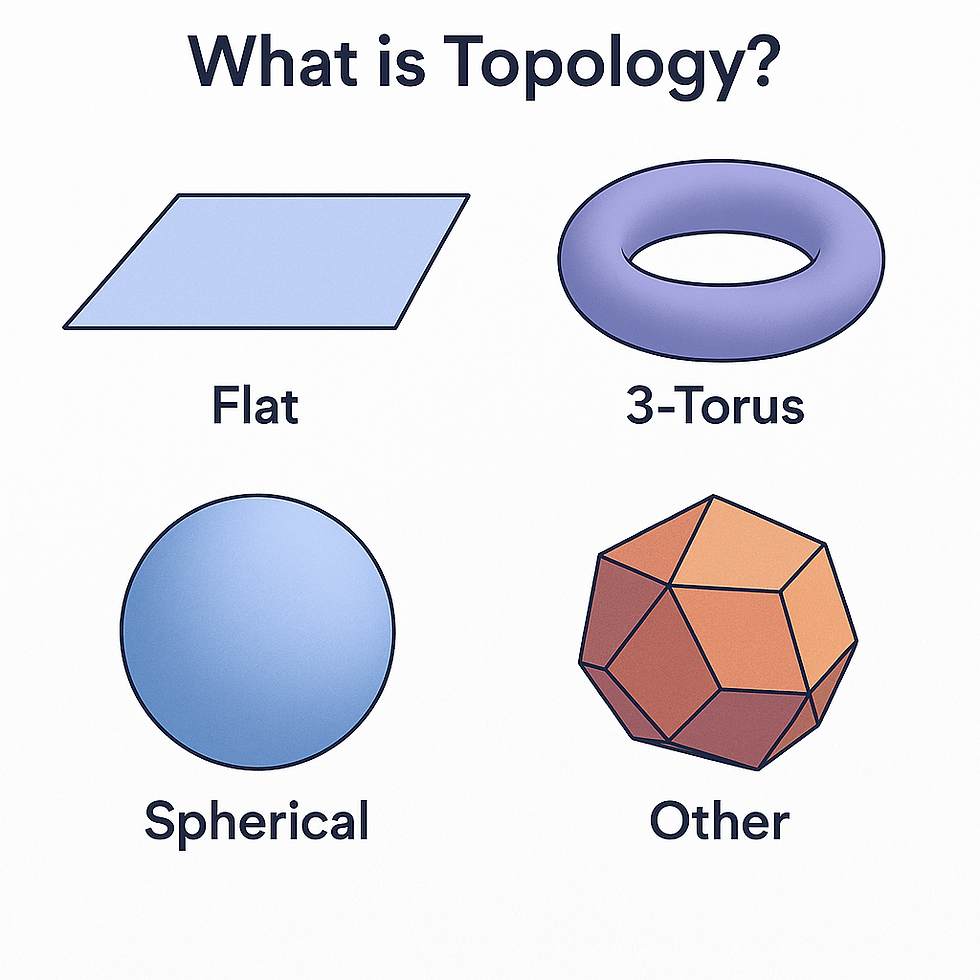What shape is space? Exploring the Universe's Topology with CMB Correlation Circles
- tanisha

- Apr 4
- 3 min read
When we picture the universe, we often imagine it stretching infinitely in all directions. But what if space loops back on itself - like the surface of a donut, or something even stranger?
This is the question scientists explore through the topology of the universe: the study of its global shape, size, and connectedness.
What is Topology?
Topology describes how space is connected on a large scale. It focuses on the fundamental shape of space—whether it’s finite or infinite, flat or curved, or wraps around itself.
Some possibilities for the universe’s topology include:
Flat and Infinite: Like an endless sheet—space just goes on forever. There’s no curvature, and light travels in straight lines forever. This model aligns with Einstein’s General Theory of Relativity and the standard cosmological model, supported by observations of the CMB)itself.
3-Torus (Donut-shaped): Finite but unbounded—if you travel far enough in one direction, you could return to your starting point. This is a closed loop, much like the surface of a donut, and a potential model for the universe.
Other Compact Topologies: These include shapes like dodecahedral or spherical spaces that also wrap back on themselves, creating a finite but boundary-less structure.

What Shape is the Universe?
The true shape of the universe is still up for debate, but here are the main contenders based on our current understanding:
Flat Universe (Infinite): Most of the current models suggest that the universe is flat, meaning it extends infinitely in all directions, and light travels in straight lines across the cosmos. This theory is supported by observations of the CMB.
Closed Universe (Spherical): This shape would be finite but still unbounded. It's like the surface of a sphere: if you travel far enough, you would eventually return to where you started.
Torus Universe (Donut-shaped): This more exotic idea suggests that the universe might have a shape like a 3D torus, where space loops back on itself in multiple directions. While this is still speculative, it’s a possibility scientists are investigating.
Other Shapes: There are also theories of multi-dimensional or more complex geometric shapes that could describe the universe. These are harder to visualize, but they open the door to different ideas about the universe’s global structure.
Clues from the Cosmic Microwave Background (CMB)
To detect the universe’s shape, scientists analyze the CMB (the faint glow of radiation from the Big Bang). It holds tiny temperature fluctuations that act like a cosmic fingerprint.
If the universe is wrapped or compact, light from the same source could reach us from different directions, producing "matched circles" in the CMB. These are identical patterns of temperature appearing in different parts of the sky, which would suggest the universe is not infinite but has a complex topology.

Why It Matters
Finite but Unbounded Universe: Finding matched circles would suggest that the universe is finite but unbounded—you’d never hit a wall, but space would still have a limited size.
Challenges the Infinite Model: It would challenge the assumption that the universe is infinite and flat, which is a core part of modern cosmology.
Questioning Our Understanding of Space: These discoveries could radically change our understanding of space, distance, and even the Big Bang itself.
Do We Know the Universe's Topology for Sure?
Not yet. So far, no clear matched circles have been found, but the search continues. It’s possible the universe is so large that the patterns are too distant to detect, or that they are hidden by noise in the data.
If the universe loops back on itself, we might be seeing the same places in space more than once—just from different directions.



Comments